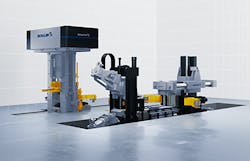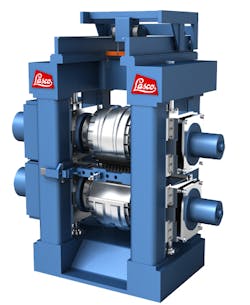In the workshop or on a plant floor, forgers may remain focused on individual processes or parameters — optimizing press strokes for example, or controlling die temperature. In the office or board room, the focus is wider — how can we coordinate all these process steps, integrate them more effectively and more productively? The latter inclination prevails on the trade show floor too, so that new ideas for forging may be found seeded among technologies for thermal processing or machine tool operations. At EMO Hannover 2017 in September, an expansive exhibition of machining technologies, there was no shortage of new ideas for forging operations.
While all of them may be considered big ideas, let’s begin with a big introduction. Following several recent projects for which it designed and installed rolled-ring preforming machinery, Schuler AG exhibited the process for the first time. It incorporates various functions that Schuler indicated will be advantageous to ring-rolling operations.
Schuler’s new rolled-ring preforming machinery, designed for ring sizes with OD up to 8,000 mm and heights up to 1,250 mm.
For example, the position of the upper bearing of the preforming machine’s mandrel can be adjusted for height. Therefore, the length of the roller mandrels can be adapted exactly to the ring geometry, which leads to considerably reduced bending and die loads. Through an additional roller mandrel drive, all forming dies can rotate during idle times too, thus cooling evenly on all sides.
The machine concept presents a comparably low construction height, which will improve the accessibility for quick changes to the roller mandrel. In combination with the main roller in a cartridge design, a die change is possible in just a few minutes, according to the system developer. Due to the short equipping times and high technical availability, Schuler also offers an economical method for small-lot production of rings.
The new series is designed for ring sizes with outer diameters up to 8,000 mm and heights up to 1,250 mm. Schuler also introduced a machine for rings with a diameter of 4,000 mm and a height of 1,000 millimeters.
For the drive of the main roller, two motors with an output of 500 kW each and taper rollers with 500 kW are provided. Customized machines with stronger drives for special materials or lager ring are also possible, of course.
Schuler also chose EMO to introduce a new servo drive-powered, 2,000-mt mechanical forging press, which is expected to increase process efficiency and throughput by optimizing the speed during forming, die spraying, and part transport
The LASCO RCW cross-wedge rolling stand is designed for pre-forming round and square material. The billet is fed radially into the rollers by a manipulator and pre-formed in individual passes.
LASCO exhibited several machines for forging operations, including the VP/VPA/VPE series preforming/multipurpose press. Its various set-up options and automation functions give it multiple applications for forward and backward extrusion, pre-forming, upsetting, stretching, trimming and more, with flexibility for stroke lengths, overall heights, tool area dimensions, and ram speeds.
LASCO’s RCW cross-wedge rolling machine was exhibited, for pre-forming round and square material. A billet is fed radially by a manipulator into the rollers and pre-formed in individual passes. The design includes a special forging roll manipulator; a manipulator gripper fitted with compensating member to balance out changes in billet lengths; direct-drive synchronization for material direction control; and optional roller temperature control functions.
The QKW cross-wedge rolling machine will pre-form or finish-form rounds or hollow shafts. Heated round bars are formed between two synchronized rollers fitted with tools. Special features of the QKW include the adjustable roller-gap; direct-drive synchronization or reverse for material direction control; optional heating/cooling temperature control; and optional roll-change manipulator.
Both of these LASCO systems operate without a flywheel, clutch, or brake due the torque motor drive. Highly dynamic and accurate operational control is achieve via two electronically synchronized servo torque motors. Electronic roller synchronization optimizes dimensioning of the roller gap and allows roller gap adjustment during rolling.
Another forging press builder, SMS Group, introduced a novel design for customizable die-spraying heads, produced by 3D printing. The group also presented a new drive technology for metal forming operations, call MEERtorque®.
The MEERtorque drive separates the ram movement from the allocation of forming energy, according to SMS. The press ram is driven directly by the acceleration servo motor located on the left side of the eccentric shaft. The continuously rotating flywheel is driven and maintained at speed by a separate, directly mounted flywheel motor arranged on the right side of the eccentric shaft, eliminating the need for additional belt drive or back shaft. This makes it possible to combine the advantages of all servo-driven presses with those of presses with conventional clutch-/brake systems.
Among the advantages of the MEERtorque arrangement are increased die life (due to reduced die contact time); reduced maintenance cost (due to reduced wear on mechanical parts; no brake required during continuous operation; increased production output; reduced volumes for supply media (e.g., compressed air, spray liquid, electric power); and smooth, quiet operation due to the elimination of the brake, gearbox, etc.
Software is on area of manufacturing technology that truly connects forging operations to upstream and downstream processes, and even to the design of parts and processes. In simulation, it’s possible to see a production process carried out even before it’s been authorized or initiated.
Simufact Forming is a software platform used by forgers and others (cold forming, rolling, open die forging, welding, joining) to evaluate process results and apply that information during the design phase. Simufact Forming can be applied to study microstructural simulation, calculation of die load, the material flow, and to predict material properties during heat treatment. Its presence at EMO was surely to appeal to forgers and those who work with or supply products to, or receive materials from, forgers.
A Simufact Forming simulation model and press force distribution indicator, shown at left; the Brankamp X7 process monitoring system, right.
Simufact Forming can be used to evaluate all relevant boundary conditions of a forming/forging process, including stress rings and spring-supported dies. The realistic prediction of the forming forces, while taking into account spring-back effects and the elastic-plastic material behavior, is necessary for a high precision simulation of cold forming processes, for example. Analyzing forming processes provides a higher process understanding of complex die designs (spring-supported dies, flashless precision forging) and helps to optimize die life through investigation of die loads.
So, Simufact took the occasion to announce a joint development with Prokos GmbH (developer of the Brankamp forming process-monitoring system) and Möhling GmbH & Co. (cold forming and cold formed components specialist) to evaluate how linking process simulation and process monitoring can improve die life.
The increasing accuracy of simulation models as well as the simulation-based predictions of the press-force progression provides users useful practical assistance for adjusting tool settings on the machine. Project results have shown this approach simplifies the production machine’s set-up and helps to prevent a systematic overloading of the dies and machines, which results in increased die life, fewer die failures, and a more robust production process overall.
An integrated approach to forging technology may not always be practical, but the big ideas are always worth consideration.



